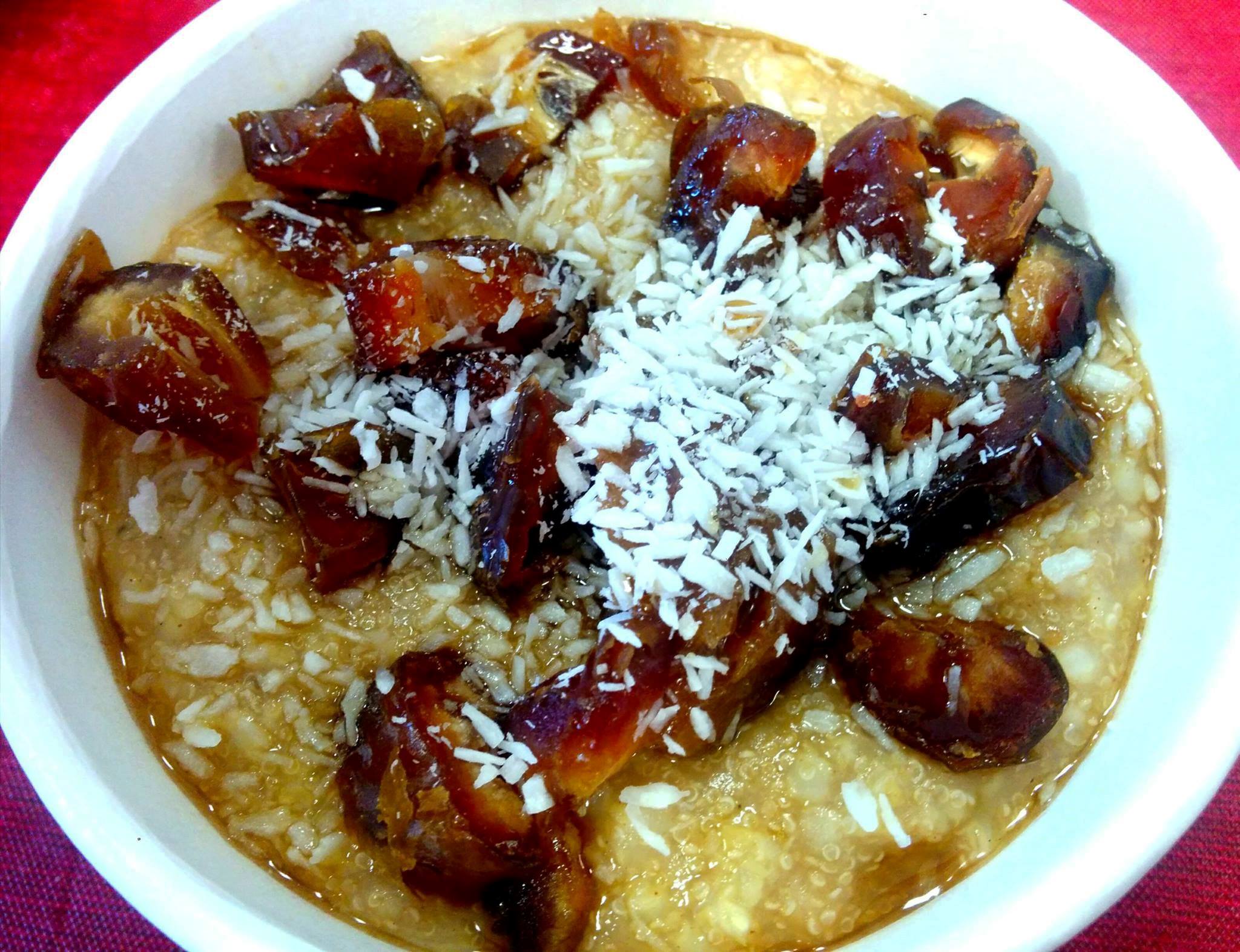What Is Porridge? Porridge Is Everything.

Amaranth millet porridge with dates, coconut and raw toffee at Brooklyn Porridge Co.
Modern urbanites have a curiously hearty appetite for old-timey peasant food. Perhaps no place better embodies this fascinating irony than the fashionably quaint Brooklyn Porridge Co. That's right, folks: porridge. You've probably heard the term, most likely in the context of an old fairy tale. It's the stuff that almost got Goldilocks killed. Almost. But, outside of storybooks, it's a word that you just don't hear so much in contemporary American society.
What is porridge exactly? Is it just some fancy European word for common oatmeal? Or, is it something more? That same question is basically what led proprietors Emily Hannon and Karyn Seltzer into the porridge business in the first place. The partners, both former managers for Le Pain Quotidien, had been brainstorming healthy food concepts. "We were talking about oatmeal and the idea of savory oatmeal, and how delicious it was," says Hannon, who was studying ancient grains at New York's Natural Gourmet Institute at the time. "And, we kind of jumped to, 'Wait a second. What's the difference between oatmeal and porridge?'"
Take a look at the top of their sprawling menu, and you'll begin to see the answer. Yes, there's oatmeal, specifically the snappy steel-cut variety. But, you'll also find grits, brown rice congee and an exotic-sounding amaranth millet that is perhaps the most flavorful of the bunch.
"The definition is, any grain simmered in liquid to become a hot cereal," explains Hannon, who was immediately intrigued by the possibilities. "We started researching porridges around the world," she says. "The more we looked into it, it's like every culture has its own form of porridge."
Likewise, it seems that some cultures have their own definition of what porridge is, as well. Australia-based writer Sambodhi Prem, author of the e-book Porridge: A Healthy Breakfast, And Cheap, Too!, for instance, distinguishes oatmeal from porridge based on the way the oats are prepared. "Around here, the word 'oatmeal' is used for oats that have been 'ground' while the word 'porridge' is used for cooked oats that have first been rolled (flattened or crushed using steel rollers)," Prem explains via email. The semantics, too, seem to shift, based on your location, he says. "Being a bit of a nerd, I've looked at the popularity of 'porridge' and 'oatmeal' as search terms in the U.K., Australia and the U.S. Both words are evenly used here (Australia), but in the U.K. 'porridge' wins."
Moreover, porridge has its own cultural connotations, as well. Not all of them positive. Beyond the anthropomorphic bears of folklore, and their unwanted discerning-diner houseguest, you may also associate porridge with orphans, destitution and other depresssing Dickensian themes. In Annie, they called it "mush." In Oliver Twist, it was "gruel." But, it's all essentially the same thing: cheap slop that serves as sufficient sustenance, if nothing else.
Today, however, it's not the cruel overlords at the workhouse or orphanage who are pushing us to eat the stuff. Rather, it's doctors, nutritionists and other do-gooders. A newly released Harvard University study, monitoring some 100,000 people over a span of 14 years, found that every ounce of whole grains that you consume each day – "the equivalent of a small bowl of porridge," as London's Telegraph helpfully points out – cuts your risk of death by five percent and specifically reduces your risk of dying from a heart attack by nine percent.
"It's healthy, it's nutritious," says Seltzer of Brooklyn Porridge Co., where the signage extolls the many virtues of eating gluten-free, non-GMO whole grains in this fashion.
Curiosity, though, might be just as big of a draw as the health perks. "We loved the fact that people were somewhat confused actually about the word porridge," says Seltzer. "We thought, you know, how many words are there, especially related to food, where people really don't know something? That kind of excited us. The more we thought about it, the more we just loved the word 'porridge' and what it conjured up. On the one hand, it was gruel and the whole Dickensian, 'Please, sir, I want some more' from Oliver Twist. But, it also conjured this feeling of warmth and nostalgia and tradition. So, we thought, 'Well, we could actually redefine this and start something.'"
Hannon and Seltzer are now attempting to "bring a level of sophistication" to the mush. At their seasonal pop-up shop in Park Slope, open from October until March, you can gussy up your chosen form of porridge with all sorts of sweet and savory toppings, ranging from simple fruits and nuts to fancier things like raw toffee and kimchi. Or, select from the house's own combinations. (See the full menu here.) "It's so versatile," says Hannon, likening the neutral base quality to risotto. "It's limitless, the toppings that you can put on it."
As for the styles of porridge themselves, the variety seems only limited by availability and pricing of any particular grain. In the past, the shop has run specials on more exotic types of porridge, made from things like teff, the ultra-healthy but tiny grain from Ethiopia. "People loved it," Hannon says. "It's a very deep flavor. But teff is really expensive and difficult to get. Like, twice the amount of amaranth, which is already higher than the rest of them."
In the future, Hannon and Seltzer hope to regularly serve a traditional Caribbean-style cornmeal porridge – you know, like the kind that reggae icon Bob Marley sang about in the popular tune "No Woman, No Cry." The pertinent lyric already appears the shop's wall, even if the precise porridge preparation isn't yet available.
"We're open to doing any type of porridge," Hannon says.
Brooklyn Porridge Co., 741 Union St., Brooklyn, NY 11215, 718-623-6668
Read more healthy living stories on Food Republic:

